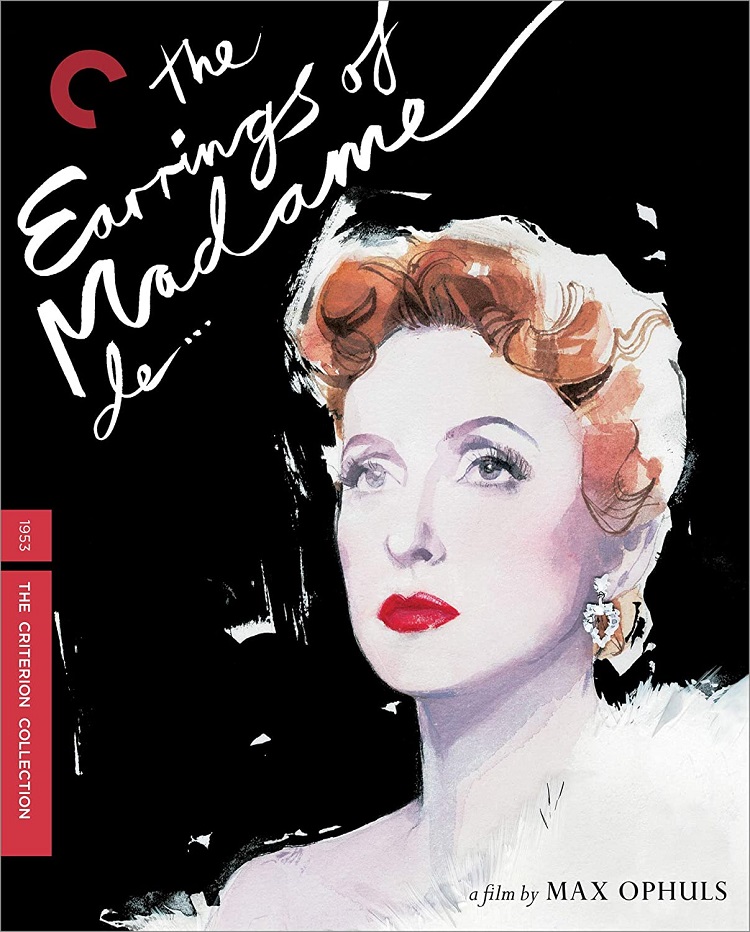
Director Max Ophuls’ penultimate film The Earrings of Madame de … is a classic French ’50s melodrama that rivals its Hollywood contemporaries. The film tells a tragic love story, loosely based on Louise Leveque de Vilmorin’s novel. So loosely in fact she can be seen in the special features saying, “they bought the title but they didn’t adapt the book.” Regardless of how accurate an adaptation it is, The Earrings of Madame de … succeeds because of the acting of its leads, the impressive cinematography, and the wonderful production design, all under the marvelous guidance of Ophuls.
Louise, a countess (Danielle Darrieux) and her husband Andre (Charles Boyer), a general in the French army, last names not given nor are they important, are having some financial difficulties. This causes her to sell, without his knowledge, the earrings he gave her as a wedding present. She doesn’t mind parting with them because the intimacy of their marriage is gone. They sleep in separate rooms, the General has a mistress, and all the young men who flirt with her don’t bother him.
In an effort to keep the sale a secret, she pretends to have lost them during a night at the opera. This backfires as the story of the earrings having gone missing reaches the papers with a suggestion they’ve been stolen. Concerned about what this could mean to his business, the jeweler (Jean Debucourt) meets with the General, who buys them back. But instead of saying anything to his wife, the General gives them to his mistress Lola (Lia Di Leo), who is heading to Constantinople. While there, her luck at roulette proves so poor, she must sell the earrings. Baron Fabrizio Donati (Vittorio De Sica), a diplomat heading to Paris, buys the earrings because they would eventually make a nice gift.
After a few chance meetings, the Baron falls for Louise and begins to woo her on the dance floor through a montage of different balls and parties they both attend while the General is away. When the General returns, she stops the affair, but her feelings continue, as seen when she faints after witnessing Donati fall from his horse. It is revealed Louise has a weak heart, but the General suspects more. As the story continues, the emotions of all three intensify, especially when the earrings reappear, leading to an inevitable clash.
The video has been given a 1080p/AVC MPEG-4 encoded transfer displayed at an aspect ratio of 1.33:1. The booklet reveals, “This new digital master was produced from a 2012 restoration undertaken by Gaumont. For the restoration, a transfer was created in 2K resolution on an ARRISCAN film scanner from the original 35mm nitrate negative at Eclair Laboratories in Epinay-sur-Seine, France.” Mid-range grays looks very good, but on occasion whites are slightly blown out and blacks can be light. There is quite a bit of soft focus throughout, likely a combination of source issues and DNR overuse.
“The original monaural soundtrack was restored from a safety positive made from the sound negative by L.E. Diapason in Epinay-sur-Seine” to create the French mono track that is available. Dialogue is clean and clear but the dubbed portions too often come across noticeably very flat, such as when the General and Lola are at train or the party sequence where Louise and Donati meet. Music and effects are understandably limited.
All the extras appeared on the 2008 Criterion’s DVD and are now in 1080i. There’s an Introduction(14 min) by director Paul Thomas Anderson. Three of Ophuls’ Collaborators appear in separate interviews. From 2005, assistant director Alain Jessua (25 min) talks about his getting into the business and Ophuls’s style, such as working with actors. Martina Muller conducted interviews in 1989 for her documentary about Ophuls with cowriter Annette Wademant (7 min), who felt Ophuls was not a good collaborator, and assistant decorator Marc Frederix (8 min), who revealed some preproduction sketches.
The Visual Essay by Tag Gallagher (17 min) highlights Ophuls’ style, such as his use of montage. Novelist Louise de Vilmorin (5 min) is taken from the November 20, 1965 episode of the French television series Demons et merveilles du cinema. She’s very critical of the films, saying they “didn’t get one thing right” and that the film is boring. I can’t speak to the former, but I disagree with the latter. There’s an engaging commentary by Susan White and Gaylyn Studlar and an 80-page illustrated booklet featuring “The Cost of Living,” an essay by critic Molly Haskell; an excerpt from Dressing Madame de … by costume designer Georges Annenkov; and Louise de Vilmorin’s 1951 source novel Madame de.
The Earrings of Madame de … is as enjoyable as a tale of this nature can be. Through their captivating performances, the cast elevates the story and makes the characters more engaging. Aside from his work with the actors, Ophuls skillful direction can be seen in the camerawork and transitions. In the aforementioned dance montage, the camera swoops about the couple, involving the viewer in the movement of the dance and the emotion of the pair. While out of the country, Louise wrote back to Donati but tore the letters up. As the torn bits of paper flit about in the wind, they transition into falling snow to reveal a passage of time.
While the video quality doesn’t reach the usual high standards one typically finds on a Criterion Blu-ray, the entire experience of film, presentation, and extras still make The Earrings of Madame de … worth having in the collection. At least until you find yourself in debt like Louise and need to sell some precious items.